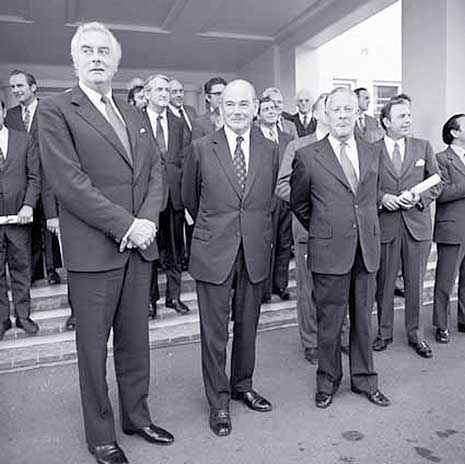THE second volume of Jenny Hocking’s biography of Gough Whitlam has attracted considerable attention for its exposure of the role of High Court justice Anthony Mason in advising John Kerr as he contemplated dismissing the Whitlam government. But there has been a surprising lack of comment about two other revelations in the biography, both based on the records of a much less controversial governor-general, Paul Hasluck.
Hasluck was governor-general from 1969 to 1974, having moved straight to Yarralumla after a parliamentary career that included the senior portfolios of defence and external affairs. In politics, Hasluck’s had been a conservative and old-world persona; it was widely contended that his failure to embrace full-blooded politicking and self-promotion had cost him the Liberal Party leadership (and hence the prime ministership) when John Gorton prevailed in 1968.
Sandwiched between that vice-regal busybody (and prolific diarist) Richard Casey and the ultimate interventionist Kerr, Hasluck has been seen by many as a non-event as governor-general. His public utterances were usually uncontroversial and his only views on the vice-regal office were offered in his Queale Lecture in Adelaide in 1972. There, in a barely disguised critique of Casey, Hasluck observed that a governor-general would “stray beyond his functions if he took sides in any argument between his advisers or preferred one minister to another, or tried to interfere in the domestic arguments of any political party.” This was precisely what Casey had done in relation to the McEwen–McMahon feud in the Coalition government and through his excessive involvement in party affairs after the disappearance of prime minister Harold Holt. The rest of Hasluck’s address revealed a viceroy endorsing the job description famously summarised by Walter Bagehot in the nineteenth century: “the right to be consulted, the right to encourage, the right to warn.”
When his Queale lecture was republished in 1979, Hasluck added the revelation that during his time as governor-general he had kept handwritten notes “after any conversation on questions of substance.” Under the thirty-year rule Hasluck’s biographer, Robert Porter, lacked access to these notes. But in her quest for material about Whitlam over a decade later, Hocking read the notes, and her findings are very interesting indeed.
The first revelation concerns an informal conversation between Hasluck and the governor of Western Australia at the time, Douglas Kendrew, who confided his involvement in detailed planning to rid Australia of the Whitlam government with the help of the non-Labor states. Given that Western Australia had a Labor government at the time (August 1973), this alleged plot would seem to have been as logistically challenging as it was outrageous. But according to Hocking, Kendrew planned to deal with the awkward problem of the complexion of the WA government by contriving to have supply rejected in the upper house, whereupon the premier, John Tonkin, would seek a “double dissolution.” Kendrew would decline the advice and use the “royal warrant” to install opposition leader Charles Court as premier.
While English vice-regal appointees like Kendrew were not necessarily selected for their keen constitutional insights, could he really have been ignorant of the fact that the Western Australian constitution made no provision for such democratic excesses as double dissolutions? As a professional historian, Hasluck would almost certainly have known. He describes the discussion as occurring over drinks, so a traditional explanation might account for the problems of detail on Kendrew’s part.
If we accept that Hasluck could not have invented such a bizarre story, Hocking’s revelation is astounding. Essentially, the governor of a state was conspiring with the opposition leader to bring down an elected state government with a view to advancing a convoluted plot to overthrow an elected federal government. Surely, this alleged plot warrants further examination, possibly by some Perth-based scholar able to dig deeper.
Hocking’s second revelation from the Hasluck papers is less spectacular, but nonetheless interesting. In her account of the 1974 double dissolution election, she cites Hasluck as having previously advised Whitlam that the theme of a “fair go” would “be the most favourable basis for the government to run a double dissolution campaign.” For a governor-general so committed to non-involvement in party affairs, this would seem an unusual intervention. Was this “encouragement” à la Bagehot? Only a detailed examination of Hasluck’s papers can clarify whether it was atypical behaviour or whether candid political advice was part of the role as he practised it.
Given the frankness of Hasluck’s account of his discussion with Kendrew, we might anticipate other interesting revelations from his encounters with a vast range of public figures, including the three prime ministers with whom he interacted as governor-general. It would be a considerable irony if this most private of politicians has left behind an unanticipated treasure trove for the interested researcher. •




